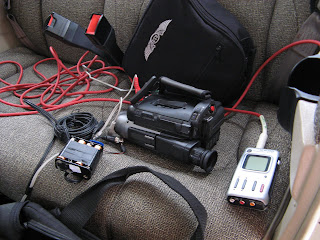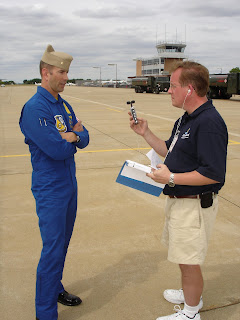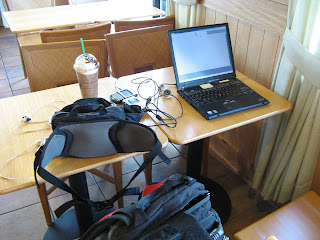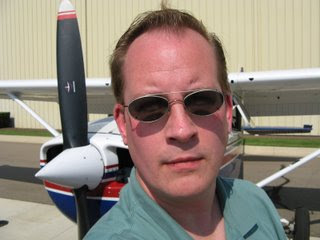 This is a regular blog post. Looking for show notes or links to show audio? Please browse the other posts.
This is a regular blog post. Looking for show notes or links to show audio? Please browse the other posts.
“Yeah, maintenance? Somebody left a blue knob, a lever, and a couple of new gages in the dash on one of your 172s. And the tach is gone. Could you check that out?”
Started the checkout in the RG yesterday at Flight 101. Wind 240 at 14, gusting to 22. (Active runway 27L-R.) Peak gust 26 and bizjets reporting shear of plus and minus 15 on final. That’s not bed-head in the picture. The wind was even blowing back the gel.
But we got up. This is the first flight of the checkout in the Cessna 172RG (the Cutlass). Flight 101, the FBO to which I’m transitioning for my airplane rental needs, has 152s, 172s, a 172RG, and Diamond DA40s. Checking out in the RG qualifies me for all of the other Cessnas on the line, so it’s efficient to go up in the RG, even if I need five hours in which to check out. Plus, I’m scheduled to go for multi training with Traverse Air this weekend and having a little experience with a complex aircraft would be a good thing.
Plus, I needed to go land something – anything – a few times to get the muscle memory back. I’d flown only twice since the instrument checkride last October and even that flying involved only two takeoffs and two landings (although I got an IPC out of the February flight).
There’s a lot to learn. I’m really glad that I flew something complex before getting into Tom Brady’s Apache. I understand constant speed props better now and also have a better sense for how busy I’m going to be on takeoff and landing.
I goofed up the first takeoff for the simple reason that I hadn’t positioned my seat correctly. The dash is a little closer to the pilot in relation to the pedals in the Cutlass than it is in the late-model 172Rs to which I’ve become accustomed. I set up the seat to put the throttle about the right distance for my arm. Taxiing was okay, so I figured that the pedals would be fine.
So I gave her full power and immediately went left because I couldn’t get enough pedal travel with my right foot. Lesson learned. Make sure that you get full travel of all of the applicable controls before you get to the hold short line.
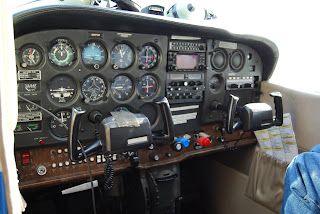 Here’s the cockpit. The blue knob is the prop control, the gear lever is to the left of the carb heat, and – yeah – there’s carb heat (after having flown fuel-injected aircraft since 2003). Procedures also call for using the electric fuel pump on takeoff and landing and that switch is at the far left. Plus, there are cowl flaps that you need to close to help avoid shock cooling of the engine. It’s nothing that thousands of pilots don’t deal with every day, but it’s new to me and I was as busy as a one-armed paper hanger in the pattern.
Here’s the cockpit. The blue knob is the prop control, the gear lever is to the left of the carb heat, and – yeah – there’s carb heat (after having flown fuel-injected aircraft since 2003). Procedures also call for using the electric fuel pump on takeoff and landing and that switch is at the far left. Plus, there are cowl flaps that you need to close to help avoid shock cooling of the engine. It’s nothing that thousands of pilots don’t deal with every day, but it’s new to me and I was as busy as a one-armed paper hanger in the pattern.
After a couple of steep turns, we headed over to Romeo to use Runway 18, where the wind was a little closer to the runway heading. It was a little too bumpy anywhere below about 5,000 feet to do slow flight productively, so we’ll do the rest of the high airwork later.
Four full-stop landings. Pretty happy with them except for the third one, in which I imposed a fair amount of side load with a nose-right touchdown.
The Cutlass cruises fast and beautifully. And it’s heavier, so it’s a little better behaved in the shear and turbulence. There’s a pronounced difference when the gear comes down. You can really feel the drag.
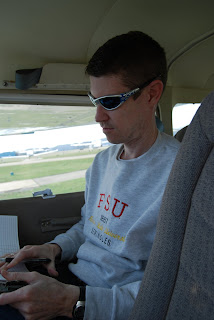
That’s Dr. (!) Andy Mawdsley in the right seat. Nice guy. Very good at letting you know his pet peeves and operational preferences, but doing it in a constructive way. Ever fly with a crusty instructor who seems to be pissed off that you don’t automatically know all of his (or her) foibles and doesn’t seem to care that you might have learned something differently and are performing to the letter of your training? Andy’s not that guy. He took the time to talk for a half hour or so before the flight, helped with the idiosynchrasies of the RG preflight, and gave me a clear expectation of what to expect on the flight.
Weather not looking good for the multi training this weekend, but I’ll call Tom today and see what he thinks.

